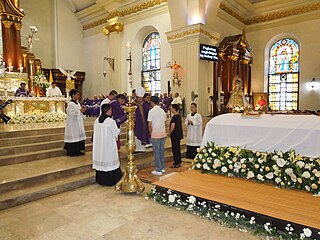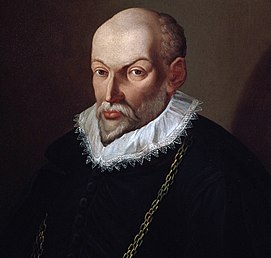
In Western classical music, a motet is mainly a vocal musical composition, of highly diverse form and style, from the high medieval music to the present. The motet was one of the pre-eminent polyphonic forms of Renaissance music. According to Margaret Bent, "a piece of music in several parts with words" is as precise a definition of the motet as will serve from the 13th to the late 16th century and beyond. The late 13th-century theorist Johannes de Grocheo believed that the motet was "not to be celebrated in the presence of common people, because they do not notice its subtlety, nor are they delighted in hearing it, but in the presence of the educated and of those who are seeking out subtleties in the arts".

An antiphon is a short chant in Christian ritual, sung as a refrain. The texts of antiphons are the Psalms. Their form was favored by St Ambrose and they feature prominently in Ambrosian chant, but they are used widely in Gregorian chant as well. They may be used during Mass, for the Introit, the Offertory or the Communion. They may also be used in the Liturgy of the Hours, typically for Lauds or Vespers.

A Requiem or Requiem Mass, also known as Mass for the dead or Mass of the dead, is a Mass offered for the repose of the soul or souls of one or more deceased persons, using a particular form of the Roman Missal. It is usually, but not necessarily, celebrated in the context of a funeral.

The Mass, a form of sacred musical composition, is a choral composition that sets the invariable portions of the Eucharistic liturgy to music. Musical Masses take their name from the Catholic liturgy called "the Mass".

Orlande de Lassus was a composer of the late Renaissance, chief representative of the mature polyphonic style of the Franco-Flemish school, and considered to be one of the three most famous and influential musicians in Europe at the end of the 16th century.

Guillaume Du Fay was a Flemish composer and music theorist of the early Renaissance from the Burgundian Netherlands. Regarded as the leading European composer by his contemporaries, his music was widely performed and copied. Du Fay held various music positions during his lifetime, and was associated with the Burgundian School as well as among the first composers of, or at least a predecessor to, the Franco-Flemish School.
Jacobus Clemens non Papa was a Netherlandish composer of the Renaissance based for most of his life in Flanders. He was a prolific composer in many of the current styles, and was especially famous for his polyphonic settings of the psalms in Dutch known as the Souterliedekens.

The Eton Choirbook is a richly illuminated manuscript collection of English sacred music composed during the late 15th century. It was one of very few collections of Latin liturgical music to survive the Reformation, and hence is an important source. It originally contained music by 24 different composers; however, many of the pieces are damaged or incomplete. It is one of three large choirbooks surviving from early-Tudor England.
Jacobus Vaet was a Flemish composer of the Renaissance. He was a representative of the generation between Josquin and Palestrina, writing smooth polyphony with pervasive imitation, and he was a friend both of Clemens non Papa and Lassus.
Marbrianus de Orto was a Dutch composer of the Renaissance. He was a contemporary, close associate, and possible friend of Josquin des Prez, and was one of the first composers to write a completely canonic setting of the Ordinary of the Mass.
Cornelius Canis was a Franco-Flemish composer, singer, and choir director of the Renaissance, active for much of his life in the Grande Chapelle, the imperial Habsburg music establishment during the reign of Emperor Charles V. He brought the compositional style of the mid-16th century Franco-Flemish school, with its elaborate imitative polyphony, together with the lightness and clarity of the Parisian chanson, and he was one of the few composers of the time to write chansons in both the French and Franco-Flemish idioms.
The Lambeth Choirbook – also known as the Arundel Choirbook – is an illuminated choirbook dating to the sixteenth century. It contains music for 7 Masses, 4 Magnificats, and 8 motets. Much of the music is by Tudor-period composers. The major contributors are Robert Fayrfax and Nicholas Ludford; between them they contributed at least ten of its nineteen pieces. Only three of Fayrfax's works have his name attached to them, but five other pieces are known as his; these, along with two by Ludford, are known from concordances in the Caius Choirbook and other manuscripts. Seven anonymous pieces exist in the book:
Nicholas Ludford was an English composer of the Tudor period. He is known for his festal masses, which are preserved in two early-16th-century choirbooks, the Caius Choirbook at Caius College, Cambridge, and the Lambeth Choirbook at Lambeth Palace, London. His surviving antiphons, all incomplete, are copied in the Peterhouse Partbooks. Ludford is well-known as being the composer of the only surviving cycle of Lady Masses, small-scale settings of the Ordinary and Propers in three parts to be sung in the smaller chapels of religious institutions on each day of the week. Ludford's composing career, which appears to have ended in 1535, is seen as bridging the gap between the music of Robert Fayrfax and that of John Taverner (1495–1545). Music scholar David Skinner has called Ludford "one of the last unsung geniuses of Tudor polyphony". In his Oxford History of English Music, John Caldwell observes of Ludford's six-part Mass and Magnificat Benedicta that it "is more a matter of astonishment that such mastery should be displayed by a composer of whom virtually nothing was known until modern times".

The Pieterskerk is a late-Gothic Dutch Protestant church in Leiden dedicated to Saint Peter. It is known today as the church of the Pilgrim Fathers, where the pastor John Robinson was buried. It is also the burial place of the scientist Willebrord Snellius.

Early music of Britain and Ireland, from the earliest recorded times until the beginnings of the Baroque in the 17th century, was a diverse and rich culture, including sacred and secular music and ranging from the popular to the elite. Each of the major nations of England, Ireland, Scotland, and Wales retained unique forms of music and of instrumentation, but British music was highly influenced by continental developments, while British composers made an important contribution to many of the major movements in early music in Europe, including the polyphony of the Ars Nova and laid some of the foundations of later national and international classical music. Musicians from the British Isles also developed some distinctive forms of music, including Celtic chant, the Contenance Angloise, the rota, polyphonic votive antiphons, and the carol in the medieval era and English madrigals, lute ayres, and masques in the Renaissance era, which would lead to the development of English language opera at the height of the Baroque in the 18th century.

The Egidius Kwartet is a Dutch vocal ensemble specialising in the music of the Franco-Flemish school, in particular of the Habsburgs, Margaret of Austria, governor of the Netherlands and her court at Mechelen. The ensemble was formed by four members of Ton Koopman's Amsterdam Baroque Choir in 1995.

Music in Medieval Scotland includes all forms of musical production in what is now Scotland between the fifth century and the adoption of the Renaissance in the early sixteenth century. The sources for Scottish Medieval music are extremely limited. There are no major musical manuscripts for Scotland from before the twelfth century. There are occasional indications that there was a flourishing musical culture. Instruments included the cithara, tympanum, and chorus. Visual representations and written sources demonstrate the existence of harps in the Early Middle Ages and bagpipes and pipe organs in the Late Middle Ages. As in Ireland, there were probably filidh in Scotland, who acted as poets, musicians and historians. After this "de-gallicisation" of the Scottish court in the twelfth century, a less highly regarded order of bards took over the functions of the filidh and they would continue to act in a similar role in the Scottish Highlands and Islands into the eighteenth century.

Music in Medieval England, from the end of Roman rule in the fifth century until the Reformation in the sixteenth century, was a diverse and rich culture, including sacred and secular music and ranging from the popular to the elite.
The Forrest-Heyther partbooks are a set of six manuscript partbooks copied in England in the sixteenth century. They are an important source of polyphonic Mass Ordinary settings by composers from the reign of Henry VIII, including John Taverner and Robert Fayrfax.












